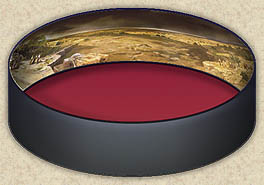
Cyclorama of Jerusalem, Panorama
45 ft / 14 M high
360 ft / 110 M circonference
City of Jerusalem
The city is seen from a hill west of Jerusalem. On the extreme left of the City may be seen three important buildings: the first is the Xystus, a gymnasium used by the Roman soldiers for their games and athletic exercices; the second, in the centre, is the tower of Antonia, said to have been the residence of Pontius Pilate, governor at the time. Here Jesus was condemned to death by Pilate, and thence they led Him away to Calvary. The third, the white edifice, is the Temple of Jerusalem. The part of the City, in which these buildings are, is known as Mount Moriah. The high mountain seen beyond the City is the Mount of Olives.

Country to the west of the city
That imposing brick arch on the left of the country is the tomb of Jeroboam the First, founder and first ruler of the Kingdom of Israel. (From about 960 to 930 years before Jesus Christ.)
The four female figures to the right of the tomb are frightened by the earthquake which occured at the Death of Christ.
Calvary, the place of the crucifixion
Jesus crucified between two thieves: the good thief Dismas is on the Saviour’s right and Gesmas, the bad one, is on His left. At the foot of the Cross of Jesus is Mary, the Mother of the crucified Saviour, who is weeping over the death of her Son. Supporting her in her sorrow is her sister Mary, the wife of Cleophas. (According to Hegesippus, Cleophas was the brother of St. Joseph.) St. John, the Beloved Disciple, is the third figure. (James the Greater and St. John were the sons of Zebedee. Their mother, Mary Salome, was the cousin of Mary, Mother of Jesus.)

